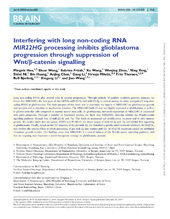Interfering with long non-coding RNA MIR22HG processing inhibits glioblastoma progression through suppression of Wnt/β-catenin signalling
Han, Mingzhi; Wang, Shuai; Fritah, Sabrina; Wang, Xu; Zhou, Wenjing; Yang, Ning; Ni, Shilei; Huang, Bin; Chen, Anjing; Li, Gang; Miletic, Hrvoje; Thorsen, Frits; Bjerkvig, Rolf; Li, Xingang; Wang, Jian
Peer reviewed, Journal article
Published version

Åpne
Permanent lenke
https://hdl.handle.net/1956/23729Utgivelsesdato
2020Metadata
Vis full innførselSamlinger
Originalversjon
https://doi.org/10.1093/brain/awz406Sammendrag
Long non-coding RNAs play critical roles in tumour progression. Through analysis of publicly available genomic datasets, we found that MIR22HG, the host gene of microRNAs miR-22-3p and miR-22-5p, is ranked among the most dysregulated long non-coding RNAs in glioblastoma. The main purpose of this work was to determine the impact of MIR22HG on glioblastoma growth and invasion and to elucidate its mechanistic function. The MIR22HG/miR-22 axis was highly expressed in glioblastoma as well as in glioma stem-like cells compared to normal neural stem cells. In glioblastoma, increased expression of MIR22HG is associated with poor prognosis. Through a number of functional studies, we show that MIR22HG silencing inhibits the Wnt/β-catenin signalling pathway through loss of miR-22-3p and -5p. This leads to attenuated cell proliferation, invasion and in vivo tumour growth. We further show that two genes, SFRP2 and PCDH15, are direct targets of miR-22-3p and -5p and inhibit Wnt signalling in glioblastoma. Finally, based on the 3D structure of the pre-miR-22, we identified a specific small-molecule inhibitor, AC1L6JTK, that inhibits the enzyme Dicer to block processing of pre-miR-22 into mature miR-22. AC1L6JTK treatment caused an inhibition of tumour growth in vivo. Our findings show that MIR22HG is a critical inducer of the Wnt/β-catenin signalling pathway, and that its targeting may represent a novel therapeutic strategy in glioblastoma patients.
